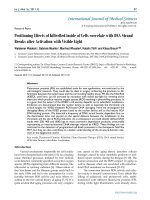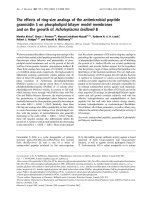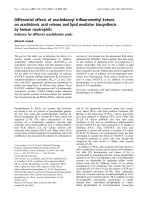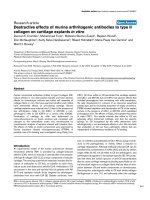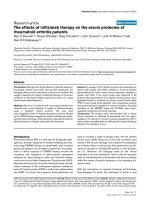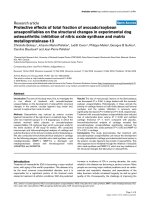Báo cáo y học: "Positioning Effects of KillerRed inside of Cells correlate with DNA Strand Breaks after Activation with Visible Light"
Bạn đang xem bản rút gọn của tài liệu. Xem và tải ngay bản đầy đủ của tài liệu tại đây (1.69 MB, 9 trang )
Int. J. Med. Sci. 2011, 8
97
I
I
n
n
t
t
e
e
r
r
n
n
a
a
t
t
i
i
o
o
n
n
a
a
l
l
J
J
o
o
u
u
r
r
n
n
a
a
l
l
o
o
f
f
M
M
e
e
d
d
i
i
c
c
a
a
l
l
S
S
c
c
i
i
e
e
n
n
c
c
e
e
s
s
2011; 8(2):97-105
© Ivyspring International Publisher. All rights reserved.
Research Paper
Positioning Effects of KillerRed inside of Cells correlate with DNA Strand
Breaks after Activation with Visible Light
Waldemar Waldeck
1
, Gabriele Mueller
1
, Manfred Wiessler
2
, Katalin Tóth
1
and Klaus Braun
2
1. German Cancer Research Center, Dept. of Biophysics of Macromolecules, INF 580, D-69120 Heidelberg, Germany
2. German Cancer Research Center, Dept. of Medical Physics in Radiology, INF 280, D-69120 Heidelberg, Germany
Corresponding author: Dr. Klaus Braun, German Cancer Research Center (DKFZ), Dept. of Medical Physics in Radiology,
Im Neuenheimer Feld 280, D-69120 Heidelberg, Germany. Phone: +49 6221-42 2495; Fax: +49 6221-42 3326; e-mail:
Received: 2010.11.13; Accepted: 2011.01.20; Published: 2011.01.21
Abstract
Fluorescent proteins (FPs) are established tools for new applications, not-restricted to the
cell biological research. They could also be ideal in surgery enhancing the precision to dif-
ferentiate between the target tissue and the surrounding healthy tissue. F P s like the KillerRed
( K R E D) , used here, can be activated by excitation with visible day-l i g h t for emitting active
electrons which produce reactive oxygen species (ROS) resulting in photokilling processes. It
is a given t h a t t h e extent of the KRED’s cell toxicity depends on its subcellular localization.
Evidences are documented that the nuclear lamina as well as especially the chromatin are
critical targets for KRED-mediated ROS-based DNA damaging. Here we investigated the
damaging effects of the KRED protein fused to the nuclear lamina and to the histone H2A
DNA-binding protein. We detected a frequency of DNA strand breaks, dependent first on
the illumination time, and s e c o n d on t h e spatial distance between the localization at the
c h r o m a t i n a n d t h e s i t e o f R O S p r oduction. A s a c o n s e q u e n c e w e c o u l d i d e n t i f y defined DNA
bands with 200, 400 and (600) bps as most prominent degradation products, presumably
representing an internucleosomal DNA cleavage induced by KRED. These findings are not
restricted to the detection of programmed cell death processes in the therapeutic field like
PDT, but they can also contribute to a better understanding of the structure-function rela-
tions in the epigenomic world.
Key words: Fluorescent Proteins; KillerRed; Photo-Dynamic-Therapy (PDT); DNA strand breaks;
ROS; Skin Tumors; subcellular Localization
Introduction
Various mechanisms responsible for cell toxicity
have been characterized in the past [1-5]. As a leading
cause chemical processes initiated by free radicals
were detected, commonly specified as reactive oxygen
species (ROS) originating from different sources, like
ultraviolet or ionizing radiation [6]. Observations of
the Gerschman and the Harman groups reach bac k to
the early 1950s and led to the assumption for a rela-
tionship between ROS activity and toxic effects re-
sulting in the free radical theory of aging [7, 8]. It is
quite evident that aging processes are very complex;
one aspect of the aging theory describes cellular
damages caused by toxic metabolic products or inef-
ficient repair systems during the lifespan [9, 10]. The
human senescence and the ROS’s impact on aging as
well as diseases which are associated with mitochon-
drial DNA mutations are discussed [11-15].
The connection between ROS activity and cellu-
lar toxicity is beyond controversial. Toxic effects like
killing of eukaryotic and prokaryotic cells, stably
transfected with different fluorescent proteins (FP),
during white light illumination were already docu-
Int. J. Med. Sci. 2011, 8
98
mented [16, 17]. An appropriate candidate for our
experiments is a red fluorescent protein, a variant
developed and documented as KillerRed by the Bu-
lina group. It is considered as a further ROS supplier
activated by visible light acting as photosensitizer
[18]. The different sensitivity of cells against ROS de-
pends on their ability of fluorescence protein forma-
tion and is FP variant dependent [16]. Recent data
elucidate different FP’s toxicity dependent on the in-
tracellular localization of the ROS producing FPs [17].
The effects are caused by different localizations
of subcellular components like membranes (in mito-
chondria, at the nuclear envelope, in cell membranes),
as well as damages of proteins of the cytoskeleton,
organelles, enzymes and finally of nucleic acids. The
mitochondrial and the nuclear located DNA represent
exceedingly sensitive targets. We designed plasmids
for expression of KillerRed and its fusions proteins
KRED-Lamin B1 and H2A-KRED. We demonstrated
their physical maps as well as their intracellular lo-
calization and their resulting effects as discussed by
Waldeck [17].
Therefore the rationale of this manuscript is the
estimation of the cell toxicity by measurements of
DNA-strand breaks in cell-c lo ne s stably transfected
with plasmids expressing KillerRed proteins (e.g.
pKillerRed-Lamin B1) after activation with white
light. K R E D -Lamin B1 is located inside of the nuclear
envelope. For comparison cells were transfected with
pH2A-KillerRed whose histone fusion partner H2A
acts as a structural protein, a crucial component of the
chromosomal chromatin. In the cells the histone
H2A-KRED fusion protein becomes part of the nu-
cleosomes with a very tight distance to DNA. With
these experiments and previous control experiments
we could demonstrate that a very close distance of
KillerRed to DNA did not allow the cells to survive.
The investigated cells were grown and treated in cell
culture, but illumination and the following labeling of
the DNA strand breaks was carried out in isolated
nuclei in the test tube (i n v i t r o ).
Material & Methods
Cell culture
DU145 human prostate cancer cells, first char-
acterized and documented by the Stone group [19],
were cultivated and maintained in RPMI1640 (Gibco
11825) amended with FCS (2%) (Gibco).
For experiments subconfluent cells were
trypsinized, harvested and plated in Petri dishes (150
mm ∅). 24 hours before measurements cells were
treated with the Poly [ADP-ribose] polymerase
(PARP) inhibitor ABT-888 (final concentration 5µM)
Recombinatory chemistry of the fusion plasmid
The construction of the pKillerRed-Lamin B1
vector is carried out according the detailed descrip -
tion as documented by Waldeck [17].
Transfe ction procedures
For the transfection of pKillerRed-L a m i n B 1 into
the DU145 cells, 5 10
6
cells were plated in a cell
culture flask (150 cm
2
); then 2 µg DNA and 36 µl
TurboFect transfection reagent (Fermentas, York,
UK) were added in 500 µl RPMI serum-free medium.
Th e t r a n s f e c t i o n p r o c e s s w a s f i n s h e d a f t e r 2 0 m i n . T h e
TurboFect, a cationic transfection reagent, is de-
scribed in the manufactor’s instructions and the
transfections steps were carried out according to the
user manual.
Isolation of nuclei
All procedures were executed on ice (max. 4°C):
DU145 cells (4.8 10
6
) were harvested and
subsequently rinsed with Hank’s Balanced Salt Solu-
tion (HBSS) (PAN P04-49505) and after centrifugation
for 5 min (800 Umin
-1
) resuspended in isotonic Tris
(137 mM NaCl; 5 mM KCl; 0.3 mM Na
2
HPO42 H
2
0;
0.5 mM MgCl
2
; 0.7 mM CaCl
2
; and 25 mM Tris/HCl,
pH 7.5). After centrifugation (identical procedure as
above) the pellet was washed with isotonic Hepes
(220 mM sucrose; 0.5 mM Cacl
2
; and 5 mM MgCl
2
)
and promptly centrifuged as described above.
The next step was the resuspension of the cell
pellet in 10 ml isotonic Hepes followed by vortexing
thoroughly in presence of NP 40 (0.5%) thoroughly
over 1 min and then cooling on ice (30 s). This step
was repeated 3-fold and the cell-fragment suspension
was resuspended in isotonic Hepes up to 50 ml and
subsequently centrifuged over 4 min (2.000 Umin
-1
).
The resulting pellet with the cell nuclei was re-
suspended in 12 ml isotonic Hepes completed with
200 mM sucrose and 5 µM ABT-888.
For the following illumination studies the solu-
tion was divided to 2 6ml aliquots wherein 1 probe
served as control.
Illumination of the nuclei
Before illumination, the solution of nuclei
(410
6
) was pipetted in a concentration of 410
6
nu-
clei pro ml onto Petri dishes with a glass bottom. The
illumination time with visible light was between 0
min and 60 min. In 20 min steps, the probes were fol-
lowed up as described as follows.
RNase digest of the nuclei
With respect to the RNA which might interfere
with the DNA labeling measurements, the RNA
molecules were removed using a specific RNase di-
Int. J. Med. Sci. 2011, 8
99
gest. Therefore the pellet containing nuclei was cen-
trifuged over 5 min (3.500 Umin
-1
). The pellet was
resuspended in 200 µl isotonic Hepes completed with
50µg/ml RNase A (Qiagen, Germany). After the di-
gestion procedure for 5 h at 37°C the nuclear suspen-
sion was completed to 1 ml with isotonic Hepes. The
mixture was centrifuged over 10 min (3.500 Um i n
-1
)
for removal of the RNA fragments, and the residual
pellet was followed up.
Labeling studies ATTO633- and ATTO465-Dyes
(TUNEL-like):
The isolated nuclei (2010
6
) were resuspended
i n a s o l u t i o n c o n t a i n i n g 7 5 µ l H 2 O ; 1 5 µ l s u c r o s e ; 3 0 µ l
TdT reaction buffer; 30 µl CoCl2; and 0.15 µl PARP
inhibitor 2-[(R)-2-Methylpyrrolidin-2-yl]-1H-b enz i -
midazole-4-carboxamide (ABT-888) (empirical and
structural formulas are examined in Figure S1).
N
N
NH
2
O
HN
CH
3
Figure S1: A B T -888’s pharmacokinetic and phamacody-
namic properties are documented by the Frost group [20].
The empirical formula is C
13
H
16
N
4
O with the mol mass of
244.29 g/mol.
The DNA in the nuclei was labeled with 0.3 µl
(50 µM) terminal-desoxy-nucleotidyl-transferase at
3’-Termini with ATTO-tagged desoxy-nucleotides
(Cat.No.: NU-803-633, and NU-803-465 Atto-Tec,
Germany) 0.3 µl (50 µM). We extended the 3’-termini
with the fluorochrome which permits the detection of
the strand breaks.
Probes treated with the reaction mix were incu-
bated over night at 37°C, then completed with isotonic
H e p e s a n d c e n t r i f u g e d o v e r 1 5 m i n ( 4 . 0 0 0 U m i n
-1
) t o
remove the excess of the fluorescent label. The nuclei
were subsequently used for the following studies.
CLSM studies
In order to estimate the intra n uclear localization
as well as the extend of the ROS-induced DNA dam -
ages after activation of the KillerRed protein with
white light, the confocal laser scanning microscopy
was used. Therefore 5 10
4
nuclei were seeded on
glass slides and investigated using the confocal mi-
croscope Leica SP5. The excitation of the ATTO465
and the ATTO633 was carried out at 458 nm and 633
nm, the emission wave length range was 590 – 700 nm
and 550-620 nm respectively.
Gel electrophoresis study
Using the alkaline gel electrophoresis technol-
ogy, the extent of the DNA single strand damage can
be visualized. For preparation of such agarose gels
(pH 11) we heated 2g SeaPrep Agarose suspended
in 180 ml H
2
O. After cooling to 40°C 20 ml 2N NaOH
w a s a d d e d a n d t h e g e l w a s c a s t e d a n d c o o l e d d o w n t o
4°C.
The gel was loaded with 0.3 µg DNA (in a 5%
sucrose solution) and electrophoresis was carried out
at 4°C during 24 h. The used electric potential was 35
V and the amperage was 10 mA.
For detection of the DNA damages, the agarose
gel was stained with ethidium bromide (EtBr) inter-
calating into the DNA.
For detection of the labeled DNA strands visu-
alization by the Typhoon imaging methodology (GE
Healthcare Europe GmbH, Germany) was used. Here
we scanned the identical agarose gel for fluoresc e nt
imaging. The visualization procedure was ca rrie d out
according to the user manual instructions with an
excitation at 633 nm and an emission wave length
range of 670 ± 30 nm.
Results & Discussion
Our first aim was to investigate the varying
am oun ts of DNA damages in the nuclei of DU145
cells after time-dependant illumination under our
treatment conditions as described in the methods part
and shown in Figure 1.
The cellular chromatin and thereby the DNA is
exposed to highly reactive ROS which induce single
strand breaks in the DNA. In cells, generally, these
toxic effects are eliminated by repair enzymes.
Poly-(ADP-ribose)-polymerases (PARP) are members
of this multi-faced repair enzyme family, wherein the
PARP-1 p r e s e n t s t h e m ajor enzyme component whose
role is critical during DNA replication, transcription
as well as in the repair of DNA strand breaks [21-24].
In case of the inhibition of PARP1 repair is blocked
and as a consequence s uch D NA -damaged cells die.
Strong PARP inhibitors were documented [25-27].
Here we used as PARP 1 inhibitor the efficient ABT-88
as discussed by the Giranda group [20].
I n o r d e r t o a v o i d f a l s e p o s i t i v e l a b e l i n g o f 3 ’ e n d s
we removed RNA extensively and we removed the
degradation products from the nuclei by extensive
washing. In Figure 2 the different fluorescence inten-
sities in nuclei of DU145 cells are shown after RNase
digest, transfected and non-transfected, activated and
Int. J. Med. Sci. 2011, 8
100
non-activated with visible light (1h) are shown. We
selected these examples to illustrate the extent of the
DNA strand breaks.
In order to possibly retain the structural proper-
ties of the nuclei we also tested an RNase treatment
after illumination, but we could not find a visible dif-
ference. (However it should be annotated that during
the preparation procedure, the illuminated nuclei
suggested a slightly increased morphologic instabil-
ity. The data of images of DU 145 cells nuclei treated
with RNase after illumination are not shown).
Figure 1 gives insight into the proportionality between the duration of activation and the increase of fluorescence in-
tensity inside of the nuclei of DU145 cells.
Figure 2 visualizes the degree of the DNA damage in nuclei as a result of DNA strand breaks caused by ROS produced
by the fluorescent protein KillerRed after activation with visible light. As controls, the fluorescence intensities of nuclei of
D U 1 4 5 c e l l s w e r e m e a s u r e d a f t e r 3 ’ -end labeling with fluorophore functionalized dNTP building blocks in non-transfected
and in transfected but non-activated cells.
As is apparent from the Figure 2 that we could
detect only faint green fluorescence signal in the nu-
clei of DU145 cells which are non transfected and
without illumination (Figure 2A) and a marginally
increased green signal in the nuclei after 60 min illu-
mination (Figure 2B). The fluorescence signals (red –
of the fusion protein KRED-Lamin B1 and green –
derived from dNTP functionalized with ATTO 633)
are hardly detectable inside of the nuclei transfected
with
pKillerRed-Lamin B1 without activation by
Int. J. Med. Sci. 2011, 8
101
illumination with white light (
Figure 2C
). The
illumination of the transfected DU 145 cells
yields clear intranuclear fluorescence signals, the
green fluorescence intensity correlates to the ex-
tent of 3’-endlabeling after DNA damaging in-
duced by KRED after light activation (
Figure 2D
).
The yellow-fluorescence signals are perinu-
clearly located and are caused by the merged red
fluorescence of the KRED and the green fluores-
cence of the ATTO 633 (
Figure 2D
).
The extreme sensitivity of the DNA against
damaging processes is documented [28-30]. Here we
also investigated the question of the dependency of
the spatial proximity of the ROS producing KRED
protein to the DNA damage extent. Therefore we ex -
posed DU 145 human prostate cancer cells expressing
H2A-KillerRed.
The H2A histone acts as a structure protein and
is part of the nuclear chromatin whereas the second
half of the fusion protein, the KRED produces highly
reactive radicals inducing damages [31] in the sur-
rounding proteins and even more important at the
adjacent D N A r e g i o n s . I n t h e Figure 3 the intracellular
localization of the fusion protein is illustrated and
shows the fluorescent signals inside of the nuclei of
DU145 cells. The permanent cloning of a
pH2A-KillerRed transfected DU145 cell line was not
successful. The cells could not survive as clones; they
changed their phenotype and their lost morphological
structures, as already documented by Waldeck [17].
For this reason the fluorescence images combined
with the images, as depicted in the Figure 3, could
solely be generated in nuclei of DU 145 cells
pH2A-KillerRed transiently transfected.
Figure 3 shows the nuclei of DU 145 cells, pH2A-KillerRed transfected, after labeling of DNA at 3’-term in i w it h T er-
minal-des ox y -nucleotidyl-transferase (TdT) and the green fluorescent marker ATT0 633. T h e l e f t p i c t u r e ( A ) s h o w s D U 1 4 5
cell nuclei, before the illumination procedure demonstrating low fluorescence signals. The right photograph (B) exemplifies
clear nucleus localized orange and partially green fluorescence signals achieved by overlaying of green and red fluorescence
signals.
The low fluorescence signal as shown on the left
side of the Figure 3A could be caused by the merged
green signal of the dNTPs label functionalized with
ATTO 633 with the and red fluorescence signal of the
KRED protein part of the fusion protein which is in -
serted into the nucleus located chromatin structure
(Figure 3A). The Figure 3B shows the same nuclei
isolated after illumination and labeling resulting in a
strong signal.
Whereas in Figure 3 the complete fluorescent
nuclear chromatin is shown after 3’-D N A e n d l a b e l i n g
of the nuclear DNA strand breaks with the fluoro-
chrome ATTO 633, the Figure 4 permits insight into
the spatial effects after illumination of DU 145 cells
expressing KillerRed-Lamin B1.
Additionally, as shown in Figure 4D, we tried to
demonstrate a more precise nuclear localization of the
DNA fluorochrome. Here the label is more distin-
guishably illustrated in a monochrome picture. It is
evident that the highest fluorescence signal resides in
the DNA located in proximity of the inner side of the
nuclear envelope.
